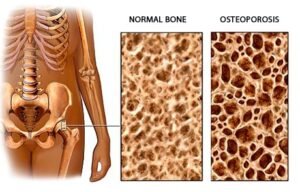Have you ever thought why people have hip fracture or wrist fracture or spine fracture after simple injuries ?
Having a fracture after falling from bed or slipping in bathroom is not normal.
All or most of these people are of age 50 years or above.
So why does it happen? The culprit is “OSTEOPOROSIS”.
What is Osteoporosis ?
Osteoporosis is a disease of the bones in which it thins and weakens so much that it breaks with minimum force. In simple terms osteo-porosis means “porous bone”. People with osteoporosis most commonly break their hip, spine, or wrist bone, but any bone can be affected.
Osteoporosis is now recognized as a world wide problem. It is estimated to affect 200 million women worldwide ! Even men are not spared. 1 in 3 women and 1 in 5 men over the age of 50 are at a risk of osteoporotic fracture. Although osteoporosis can strike at any age, it is most common among older people, especially older women.

What causes Osteoporosis?
Our bones are living tissues and are constantly changing. This change is so slow that we hardly realize it. Throughout our lives, the body breaks down old bone and replaces it with new healthy bone. We attain a maximum bone density at the age of 20-25 years (peak bone mass). As we grow old, the process of breaking down bone increases and less new bone is formed.
In osteoporotic people, this new bone has a poor framework and can break easily.
Osteoporosis depends on these factors:
- Peak bone mass
- Rate of bone break down
- Rate of new bone formation
It is often called “silent killer” because bone loss occurs without symptoms. People may not know that they have weak bones until a sudden bump, or fall causes a bone to break. The resulting fracture can prove to be costly. The patient may need a plaster, operation, and sometimes may have to live with a long term disability.
Prevention, diagnosis and treatment
Now-a-days there are various tests and scans available to diagnose osteoporosis. The good news is that there are many steps that can be taken to prevent and treat osteoporosis. With a combination of lifestyle changes and appropriate medical treatment, many fractures can be avoided.
